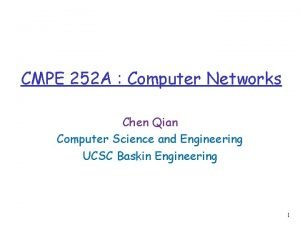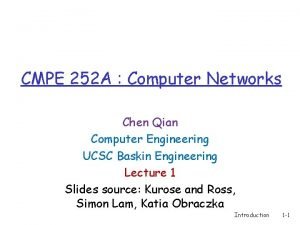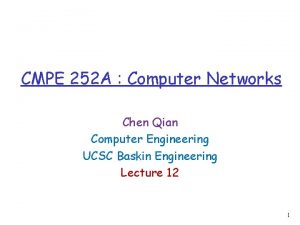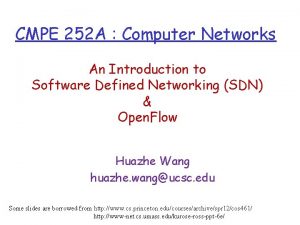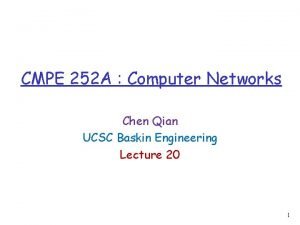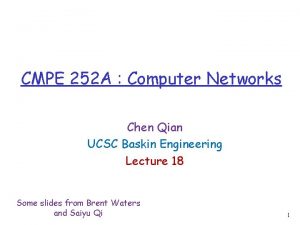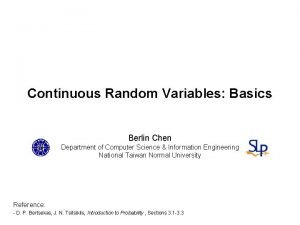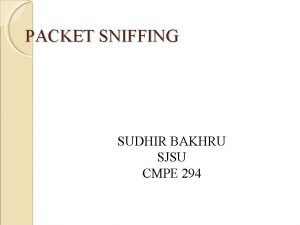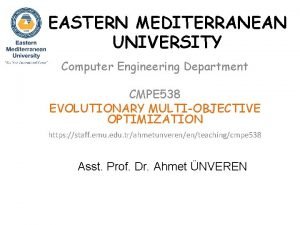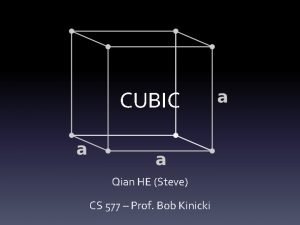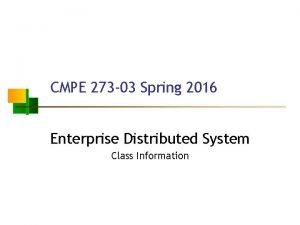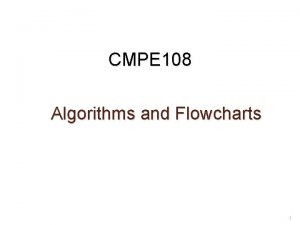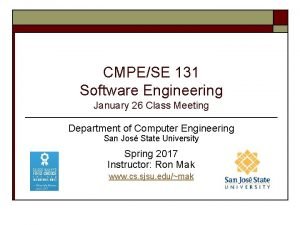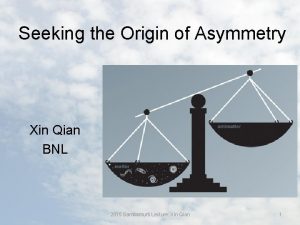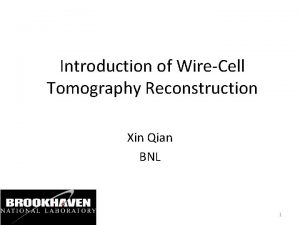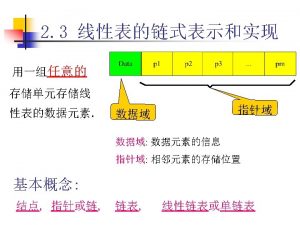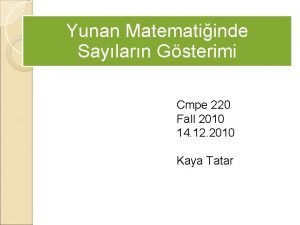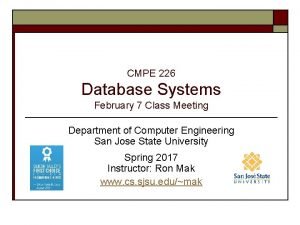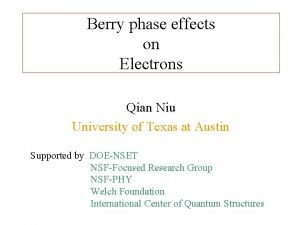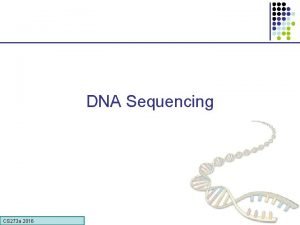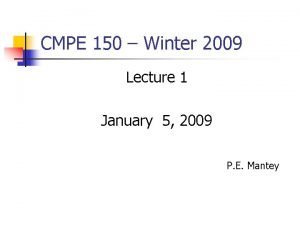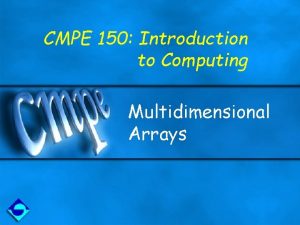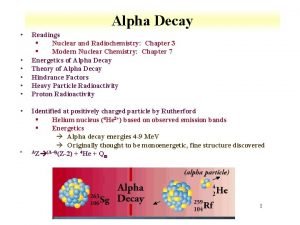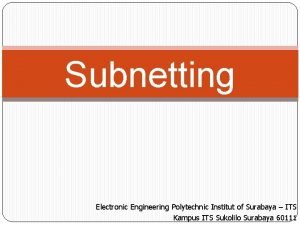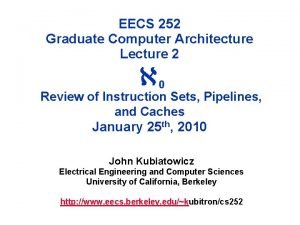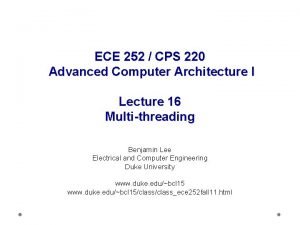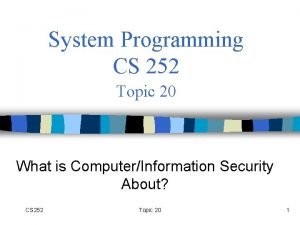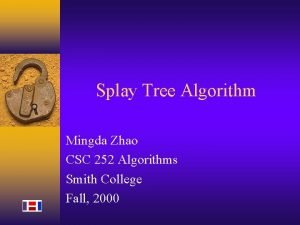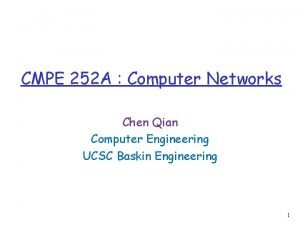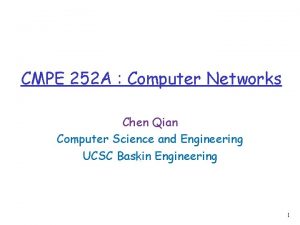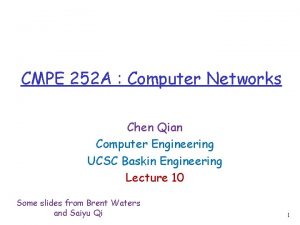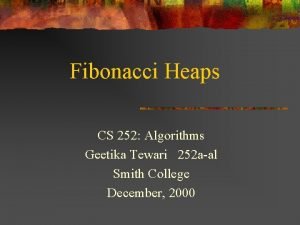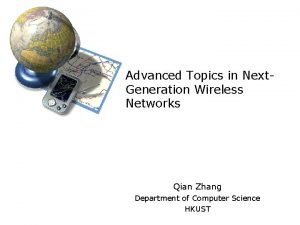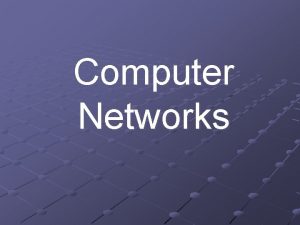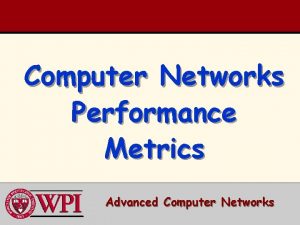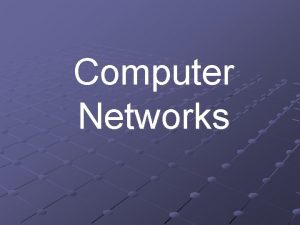CMPE 252 A Computer Networks Chen Qian Computer









































































- Slides: 73

CMPE 252 A : Computer Networks Chen Qian Computer Engineering UCSC Baskin Engineering Lecture 12 1

Jellyfish: Networking Data Centers Randomly Paper by Ankit Singla, et. al. NDSI 2012. Some figures are from slides presented by Chi-Yao Hong, UIUC.

q Facebook v ‘Add capacity On a DAILY BASIS’ q Amazon http: //news. netcraft. com/archives/2013/05/20/ amazon-web-services-growthunrelenting. html

Fat-Tree Topology l a t n e m e r ? c ? n h I t w o gr

Structured networks

Fat tree: Structure VS Limit q N_switches: • 3 -level Fat tree : 5 k 2/4 q for fat tree using k-port switches v 24 -port 3456 hosts v 32 -port 8192 hosts v 48 -port 27648 hosts q What for 10000 hosts? q Over utilize? Leave unused ports?

Goals q Bandwidth & Capacity v Better VM Placement Reduce Traffic v Better Topology Avoid Bottleneck v Robustness Failure resistance q Flexbility: Incremental Expansion v Easy to add VM v Easy to remove VM

Jellyfish : no structure

q Topology of jellyfish networks for 432 severs, 180 switches, degree = 12

Random graph q Regular Graph v RG(n, r) v Each vertex has the same degree r q Random Regular Graph v Random sampled from all RG(n, r) v Hard to generate • Question: How to generate?

Not-so-uniform Random-RG(n, r) : : RRG(n, r) q Procedure to modify RRG(n-1, r) to RRG(n, r) q r=3 q RRG(4, 3) q RRG(5, 3)


Goals q Bandwidth & Capacity v Better VM Placement Reduce Traffic v Better Topology Avoid Bottleneck q Incremental Expansion v Easy to add VM v Easy to remove VM

About the Evaluation q bisection bandwidth: Theoretical calculation for RRG, v Bollobas’ theoretical lower bounds q Throughput: random permutation traffic v Each host choose one to send (at full speed)

Jellyfish VS LEGUP

Vs. Fat. Tree Bisection bandwidth Jellyfish: larger B-bandwidth using same # switches & servers Jellyfish: more servers under the same B-bandwidth and # switches

Lower cost

Better failure resilience

Larger Throughput

Jellyfish vs. Small World Ring (2 reg + 4 rand) Small World 2 D Torus (4 reg + 2 rand) q Smallworld: grid + random Small World 3 D Hexagon Torus (5 reg + 1 rand)


Reason of better performance q




Better than jellyfish ? ? ? q More hosts using same # of switches? q Connecting more switches , each of which has same # ports, (limit the diameter) q How many switches can be connected , with 3 switch-to-switch ports , and switch-toswitch path length <= 2? q Petersen Graph

Degree-diameter-graph

q Degree-Diameter Graph have (nearly) highest throughput q Jellyfish is only little bit worse.

But… q Practical constraint: v Routing / Congestion Control v Cable

Routing & Congestion Control , d e tiliz q Utilize capacity without structure ully u f s i ity c q no layers! a p a c e l b a il a v a l l a If q Routing : v ECMP: fail to provide large path diversity v K shortest path: q Congestion Control v TCP/ multipath TCP

K-shortest path q Different Path v S-e 1 -e 2 -e 3 -…ex. . . -en-T v S-e 1 -e 2 -e 3 -…ey…-em-T q Algorithm to find 2 nd-shortest path: v Find a shortest path P from S to T in G v For each e in P v …Remove e from G v …Calculate shortest path on G , namely SP(e) v …add e back to Graph v Return 2 min(SP(e)) O(k N*Shortest. Path(N))

K-shortest path forwarding q Shortest Paths (S, T): SAB 1 C 1 DT, SAB 2 C 2 DT, SAB 3 C 2 DT, S (S, T) A A A (A, T) B 1 B 2 B 3 B A C D T (B 1, T) C 1 A A (B 4, T) C 2 A A

Inter-switch link’s path count in ECMP and k-shortestpath routing for random permutation traffic at the server-level on a typical Jellyfish of 686 servers. For each link, we count the number of distinct paths it is on.

Multi Path TCP (MPTCP) http: //blogs. citrix. com/2013/ 08/23/networking-beyondtcp-the-mptcp-way/

q Packet simulation results for different routing and congestion control protocols


cabling q Jellyfish uses 20% less # cables ,

Cabling in large data centers q Topology generated automatically, q Cables connected manually. . ( 10% of cost) q Error detect : link-layer discovery protocol.

Jellyfish of Jellyfish q Restrict some connections in pod q Result: 2 -layered random Graph

Jellyfish of Jellyfish q Restrict some connections in pod q Result: 2 -layered random Graph

Cables between pods can be aggregated

Conclusion q Bandwidth & Capacity q Incremental Expansion q Lower Cost q Limitation: slow to compute forwarding paths. Large forwarding tables.

Space Shuffle: A Scalable, Flexible, and High-Bandwidth Data Center Network Ye Yu and Chen Qian


Motivation: Goals of Data Center Design High-bandwidth • Data center applications generates high internal & external communication Flexibility • Adding servers and expanding network bandwidth incrementally. Scalability • Routing and Forwarding should rely on small forwarding state.

Motivation: Existing Data Center Architectures Network Bandwidth Fat. Tree No shortest paths. Good [SIGCOMM’ 08] Does not support multipath well. SWDC Fair [SOCC’ 11] Jellyfish [NSDI’ 12] Incremental Growth (Flexible) Forwarding State per switch (Scalability) No Fixed Greedy Routing Yes Constant Better than Large and grows Random Interconnection Yes Fat. Tree & SWDC fast K-shortest path routing is inefficient. Big forwarding state.

Motivation: Goal of Space Shuffle (S 2) • How to build a flexible data center architecture that achieves high-throughput and scalability ? • Approach: Greedy routing on random interconnection. • Challenges: • How to build a random interconnection that enables greedy routing? • How does the greedy routing protocol achieve high-throughput and near-optimal path length?

Outline • Motivation • Space Shuffle Data Center Topology • The Routing Protocol in Space Shuffle Data Center • Discussion & Evaluation

S 2 Topology Construction -Assign Servers • Servers and Top-Of-Rack switches. • Uniformly assign servers to switches. • Connect servers to switches. • The rest ports are used for inter-switch connections.

S 2 Topology Construction: -Virtual Coordinates •

S 2 Topology Construction: -Virtual Spaces • Switch ID Coor. 1 A B C D E F G H I 0. 05 0. 13 0. 23 0. 36 0. 42 0. 51 0. 63 0. 78 0. 91 Coor. 2 0. 17 0. 62 0. 91 0. 42 0. 53 0. 58 0. 73 0. 26 0. 97 0 0 A I H C G Space 1 G F C B E D I A Space 2 B F E D H

S 2 Topology Construction: -Connect the switches C I A G H B F E D I A I B H A B C I C A • A switch is physically H connected to switches C G Space 1 Space 2 DH that are adjacent to itself G in at least one space G B D F D E E F F E

S 2 Topology Construction: -Connect the switches • A I B H C D G F E

S 2 Topology Construction: -Deploy-as-a-whole Construction • Assign Step 1 hosts / switches • Generate coordinates Step 2 (randomly) • Wire the network according to the Step 3 coordinates.

S 2 Topology Construction: -Incremental Construction • Add a new switch T into existing S 2 network • Assign coordinate for T. • For each space: • Place T on the circle • Find the switch SL and SR on the left/right side of T • Disconnect SL, SR SR • Connect T, SL; Connect T, SR SL T

Outline • Motivation • Space Shuffle Data Center Topology • The Routing Protocol in Space Shuffle Data Center • Discussion & Evaluation

Routing Protocol in S 2: -Routable Address • Step 1 Step 2 • •

Routing Protocol in S 2 -Definition of Distance • Switch Coor. 1 Coor. 2 A C 0. 05 0. 23 0. 17 0. 91 CD(0. 05, 0. 23) = |0. 23 -0. 05| = 0. 18 CD(0. 17, 0. 91) = 0. 17+(1 -0. 91) = 0. 28 MCD 2(A, C) = min(0. 18, 0. 28)= 0. 18 0 0 A C C A

Routing Protocol in S 2 -Forwarding Decision using MCD • Switch MCD to the destination The switch with minimum H 0. 35 MCD to the destination gets the pac A 0. 18 D 0. 13 Minimum of Minimum CD: Greediest G 0. 19 I 0. 06

Routing Protocol in S 2 -Multipath • Next-hop candidates: all neighbor switch with smaller MCD to the destination than current. Switch MCD to the destination Current 0. 3 Neighbor 1 0. 5 Neighbor 2 the packet goes to the 0. 1 destination Neighbor 3 0. 2 as long as MCD decreases Neighbor 4 0. 4 • It provides enough path diversity by doing such selection only on the first switch of the path.

Routing Protocol in S 2: -Balanced Random Coordinates More traffic on links with small end-to-end MCD values. Uniformly distributed coordinates improves load balancing.

Outline • Motivation • Space Shuffle Data Center Topology • The Routing Protocol in Space Shuffle Data Center • Discussion & Evaluation

Evaluation • Topology property • Routing efficiency • Practical throughput

Evaluation -Topology Property Bisection bandwidth S 2 and Jellyfish: Flexible Fat. Tree: Fixed # of switches S 2 & Jellyfish topologies share similar theoretical throughput, better than Fat. Tree.

Evaluation -Routing Table Length • 10 inter-switch ports

Evaluation -Routing Path Length SWDC: long routing paths, lower throughput. S 2: near-optimal routing paths Jellyfish: optimal paths , expensive 12 inter-switch ports

Evaluation -Practical Throughput Greedy routing of S 2 exploits the path diversity. S 2 achieves near-Jellyfish S 2 & Jellyfish throughput. both outperform SWDC 250 -switch 500 -host network

Comparing S 2 with Jellyfish Construction Routing S 2 Coordinates Ring Topology Greediest Jellyfish Generate ‘Almost’ Random Regular Graph K-shortest path Hard to fit a Jellyfish topology into a routable coordinate space

Key-based Routing: -Definition • Key-value stores • https: //www. facebook. com/photo. php? fbid= 677700648959984 • Key-based Routing: route to the destination using the key of the content. (Not necessarily to know the IP) • IP-based Routing: IP of the destination.

Key-based Routing: -Delivery Guarantee • For any destination coordinate X, greediest routing will route the packet to a switch S, • S is closest to X in at least one space. • Solution: Keep one replica in each of fist r spaces and route using MCDr , r <=L • For data a with key Ka, use global hash function H to calculate the destination coordinate X=H(Ka) • In each of the r spaces, the access switch of the server for a is selected using global hash function H(Ka)

S 2 Topology Construction-Overview • H servers and N Top-Of-Rack switches. • Uniformly assign switches to servers. • Generate Virtual Coordinates of switches. • Connect the switches according to the coordinates, using the rest ports. (x 1, x 2, … ) The rest ports are used for inter-switch connections

Summary High-bandwidth • S 2 demonstrate high-bandwidth and high network throughput. Flexibility • S 2 supports incremental construction. Scalability • Greedy routing in S 2 only requires constant size of routing state.

Thank you!
 Chen qian ucsc
Chen qian ucsc Chen qian ucsc
Chen qian ucsc Cmpe 252
Cmpe 252 Cmpe 252
Cmpe 252 Cmpe 252
Cmpe 252 Qian chen ucsc
Qian chen ucsc Chen chen berlin
Chen chen berlin Difference between virtual circuit and datagram
Difference between virtual circuit and datagram Backbone networks in computer networks
Backbone networks in computer networks Cmpe 294 sjsu
Cmpe 294 sjsu Chuang qian ming yue guang li bai
Chuang qian ming yue guang li bai Hen duo qian
Hen duo qian Computer engineering emu
Computer engineering emu Steve qian
Steve qian Cmpe 280
Cmpe 280 Cmpe 273
Cmpe 273 Convert flowchart to pseudocode examples
Convert flowchart to pseudocode examples Cantor paradoksu
Cantor paradoksu Sheri tague purdue
Sheri tague purdue Qian-li xue
Qian-li xue Kenny yap qian hu
Kenny yap qian hu Cmpe 131 sjsu
Cmpe 131 sjsu Cmpe 280
Cmpe 280 Bill gates
Bill gates Wang qian av
Wang qian av Qian janice wang
Qian janice wang Statdx elsevier
Statdx elsevier Xin qian bnl
Xin qian bnl Wirecell
Wirecell Ron mak sjsu
Ron mak sjsu Cmpe 280
Cmpe 280 Sima qian
Sima qian Zhao qian malaysia
Zhao qian malaysia Cmpe 220
Cmpe 220 Cmpe 212
Cmpe 212 Cmpe 280
Cmpe 280 Cmpe 226
Cmpe 226 Cmpe150
Cmpe150 Qian niu
Qian niu Niu
Niu Winnie qian
Winnie qian Dr abet
Dr abet Junhui qian
Junhui qian Georg cantor kimdir
Georg cantor kimdir Junhui qian
Junhui qian Harvard catalyst biostatistics
Harvard catalyst biostatistics Variste galois
Variste galois Niadela descargar
Niadela descargar Cmpe 273
Cmpe 273 Duygu çelik ertuğrul
Duygu çelik ertuğrul Cmpe 150
Cmpe 150 Cmpe 150
Cmpe 150 Cmpe 150
Cmpe 150 Acordada 252/02
Acordada 252/02 Cf-252 decay scheme
Cf-252 decay scheme Simplify radicals calculator
Simplify radicals calculator Hops history questions
Hops history questions 4 en hexadecimal
4 en hexadecimal 252 nomreli mekteb
252 nomreli mekteb 252 netmask
252 netmask Skema ip address
Skema ip address 252 basics
252 basics Tentukan faktorisasi prima dari 252
Tentukan faktorisasi prima dari 252 252
252 Ece252
Ece252 Drawing ie
Drawing ie La factorización prima de 504 es
La factorización prima de 504 es Msc.252(83)
Msc.252(83) Dfars 252
Dfars 252 Ece 252
Ece 252 Dfars 252 204 7012
Dfars 252 204 7012 Cs 252
Cs 252 Mingda zhao
Mingda zhao Florida statute 252
Florida statute 252
